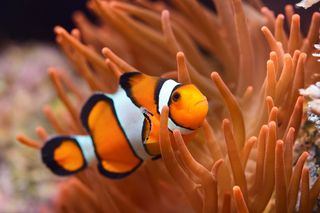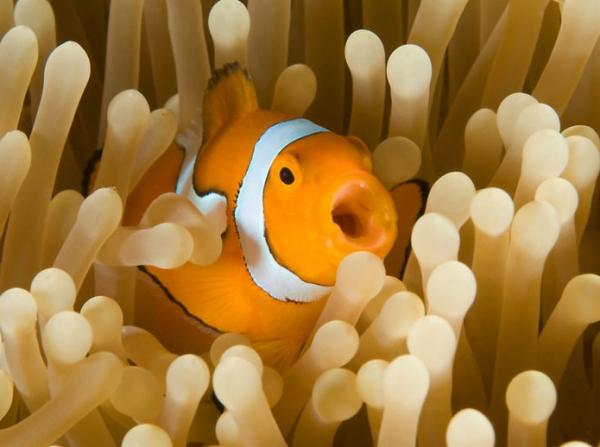Half Of A Clownfish Animated Clown Fish
Half Of A Clownfish Animated Clown Fish
Facts About Clownfish

Best known for existence featured in the movies "Finding Nemo" and "Finding Dory," the clownfish has get a popular aquarium pet. Nemo and his dad, Marlin, are ocellaris clownfish, as well called false clownfish or clown anemonefish. Anemonefish are so-named for the body of water anemones in which they make their homes. There are 28 species of anemonefish, and they come in many colors, such as pink, red, yellow, black, dark-brown and multi-colored stripes.
Size & description
Almost false clownfish are orange with three white bands on the head and body. The white bands are outlined in blackness. Their bodies are a chip more than three inches (88 millimeters) long on average, but they may grow upwardly to 4 inches (110 mm), according to the Beast Diversity Web (ADW). The tail is rounded and the dorsal fin is lined with 11 spines.
Habitat
False clownfish live in the coral reefs off the coasts of Australia and Southeast Asia as far north equally southern Japan. They are found mainly around sure kinds of anemones, a animate being that anchors itself to the bounding main floor and uses its tentacles to attract food. The anemone's tentacles have stinging cells called nematocysts that release a toxin when prey or predator touches it.
Clownfish, however, develop immunity to the toxin past very carefully touching the tentacles with unlike parts of their bodies, according to National Geographic. A layer of mucus builds upwardly, protecting the clownfish from the toxin. The pair forms a symbiotic relationship. The anemone provides protection and leftovers for the clownfish, while the clownfish brings food to the anemone and preens its host, removing parasites.
Habits
All anemonefish, including clownfish, are hermaphrodites. They are all born male, according to National Geographic. They have the power to plough themselves female, but once the change is made, they tin can't get back to existence male. Sometimes the change is made when mating. Two males will become mates and the larger, dominant fish will get the female.
These social fish live in groups that are led past one dominant female, according to the ADW. The 2nd largest fish is the dominant male person while all of the other fish in the grouping are smaller males. If the female dies, the dominant male person volition become a female to replace her. The largest of the smaller males will then become the dominant male person of the grouping.
Clownfish communicate by making popping and clicking noises, according to a study on the journal PLOS 1. Researchers say the chatter helps maintain the rank and file among group members. "Audio could be an interesting strategy for preventing conflict between group members," pb study author Orphal Colleye, a postdoctoral fellow at the Academy of Liège, Kingdom of belgium, told LiveScience in a 2012 commodity.

Diet
Clownfish are omnivores, which means they eat meat and plants. They typically consume algae, zooplankton, worms and modest crustaceans, co-ordinate to the National Aquarium.
When pocket-size, the fish tend to stay within the confines of their anemone host. Every bit they go larger, they will seek out food, though they don't venture much more than a few meters from the anemone, according to the ADW.
Mating & offspring
Fiddling is known specifically near false clownfish mating behaviors, just the general behaviors of anemonefish are known. All anemonefish are monogamous. Before spawning, the male person prepares a nest by clearing a spot on bare rock nigh the anemone, according to the ADW. He then courts a female with a show of extended fins, biting and chasing, according to the Florida Museum of Natural History. He chases the female to the nest, merely subsequently that it is up to her to brand the adjacent motility.
She will make several passes over the nest before depositing her eggs. She volition lay from 100 to 1,000 eggs, which are three to 4 millimeters long. The male then passes over the nest and releases sperm to fertilize the eggs. And so, the female person swims off.
The male does most of the "egg sitting." He will fan them and consume any eggs that are infertile or damaged by fungus, according to the ADW. The eggs hatch 6 to viii days later. The larvae bladder away and spend nigh 10 days adrift. They start their lives articulate or transparent, only every bit they begin to mature they start to proceeds the color of their species. Every bit juveniles, the young volition settle to the bottom of the reef to search for a host anemone.
Classification/taxonomy
This is the taxonomy of fake clownfish, according to the Integrated Taxonomic Information System (ITIS):
Kingdom: Animalia Subkingdom: Bilateria Infrakingdom: Deuterostomia Phylum: Chordata Subphylum: Vertebrata Infraphylum: Gnathostomata Superclass: Osteichthyes Class: Actinopterygii Subclass: Neopterygii Infraclass: Teleostei Superorder: Acanthopterygii Guild: Perciformes Suborder: Labroidei Family: Pomacentridae Genus: Amphiprion Species: Amphiprion ocellaris
Conservation condition
Ocellaris clownfish are not endangered. However, in the last generation, 15 to 30 percent of the world's reefs have been lost, according to the ADW. Some of the devastation has been caused past fishermen catching clownfish to sell as pets.
According to National Geographic, since "Finding Nemo" premiered clownfish sales have tripled. Conservationists are concerned almost the "Nemo Event," every bit some areas are overfished to meet the demand for these pop aquarium fish. Also, according to the Aquarium Welfare Association (AWA), many people bought the clownfish without knowing how to properly intendance for them. Inspired past a line in the movie, hundreds of children flushed their clownfish downward the toilet in the hope of setting them free.
Other facts
Clown anemonefish (Amphiprion ocellaris) are called false clownfish because they resemble the orange clownfish (Amphiprion percula). At that place are some subtle differences between them, co-ordinate to the Florida Museum of Natural History:
- The clown anemonefish has sparse black bands, while the orange clownfish has thick black bands separating the orange and white coloration of the body.
- The clown anemonefish often has a slightly less brilliant color than the orange clownfish.
- Viewed head-on, the clown anemonefish's head appears plain while the orangish clownfish'south head has a pronounced bulging face similar to a frog.
- The clown anemonefish's eyes are grayish orange and announced to exist larger than they actually are; the orange clownfish has a bright orange iris, which has the issue of making the eyes look smaller.
Boosted Resource
- Florida Museum on Natural History: Amphiprion ocellaris
- National Wildlife Federation: Clownfish
- University of Michigan: Maroon Clownfish
DOWNLOAD HERE
Half Of A Clownfish Animated Clown Fish
Posted by: hutterwhimeldreved.blogspot.com

0 Response to "Half Of A Clownfish Animated Clown Fish"
Post a Comment